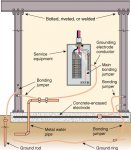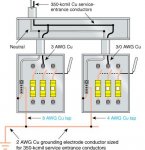Infinity, we can go back and forth with this all day. I understand your stance and code-wise I agree with you. But not everyone else does, including New Jersey inspectors. And I am sick of going back to jobs to Cadweld the bonding jumpers on multi-family houses because the inspector says it's the GEC and needs an irreversible connection. As I mentioned, even members of this forum and other electrical groups also feel that way. It is an interpretation, and as such the AHJ is going to be the final word on the matter unless the state wants to step in and clear it up, which they haven't after numerous calls.
So I would like a way to splice (2) #4's together both to extend and to tap. As far as I know, C-Taps would be the best way to tap for this purpose, but I am open to other suggestions.
So I would like a way to splice (2) #4's together both to extend and to tap. As far as I know, C-Taps would be the best way to tap for this purpose, but I am open to other suggestions.
Last edited:



